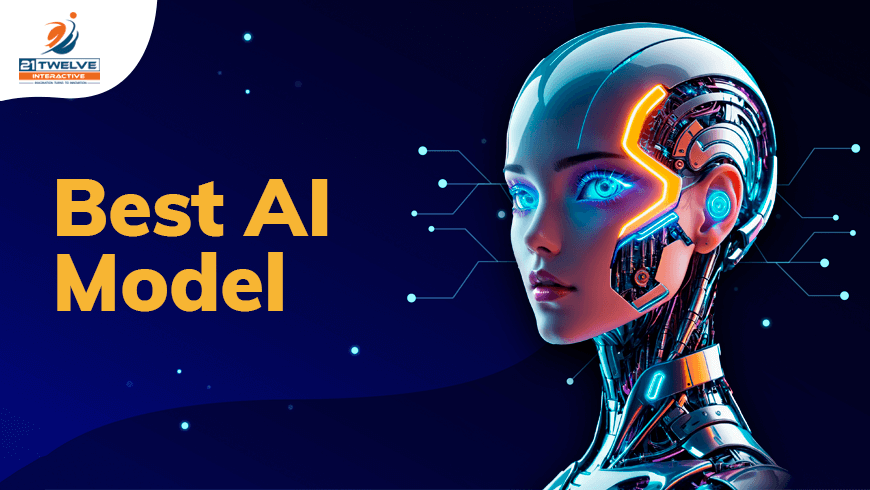
Artificial Intelligence has taken center stage, revolutionizing almost every industry day by day. The advent of AI Model opens the door to a world of endless possibilities.
Every Artificial Intelligence Development Company focuses on delivering customized AI solutions that address specific business challenges and opportunities. But in the middle of all the excitement, you might be asking yourself, “What is an AI model exactly, and why is selecting the right one so important?”
Selecting the right AI model is more important as it directly impacts the system’s performance and accuracy. Data from a survey of AI practitioners reveals that 78% prioritize model accuracy, while 65% focus on the scalability of the chosen model. Here, we will discuss how to choose the best AI model for your application.
Table of Contents
- Brief overview of AI’s impact on various industries
- Understanding AI Models
- Identifying Your Needs
- Evaluating Model Performance
- Data Considerations
- Computational Resources and Infrastructure
- Ease of Implementation
- Scalability and Maintenance
- Cost Considerations
- Ethical and Regulatory Considerations
- Conclusion
Brief Overview of AI’s Impact on Various Industries
AI’s impact on various industries is profound, revolutionizing traditional processes and driving innovation across sectors. In healthcare, AI facilitates faster and more accurate diagnosis through medical imaging analysis and personalized treatment recommendations.
In finance, AI-powered algorithms enhance risk management, fraud detection, and trading strategies. Retail experiences a transformation with AI-powered recommendation systems and personalized shopping experiences.
Manufacturing benefits from AI-driven predictive maintenance, optimizing production efficiency and reducing downtime. Additionally, AI improves customer service across industries through chatbots and virtual assistants, improving responsiveness and engagement.
Overall, AI’s mesmerizing capabilities enable industries to unlock new opportunities. Companies are looking to hire AI engineers skilled in utilizing AI’s transformative potential across various industries.
Understanding AI Models
AI models are the backbone of artificial intelligence applications, enabling them to recognize patterns, make predictions, and automate decision-making processes. To understand AI models effectively, it is important to know their types and functionalities.
☛ Types of AI Models:
- Supervised Learning Models are trained on labeled data, where the input-output pairs are provided. They learn to predict the output based on input features.
- Unsupervised Learning Models are trained on unlabeled data. The algorithm identifies patterns and structures within the data without explicit guidance.
- Semi-supervised learning models combine aspects of both supervised and unsupervised learning. The model then applies this initial learning to label a bigger dataset, a technique known as “pseudo-labeling.” This type of model is useful for both descriptive and predictive reasons.
- Reinforcement Learning Models learn through interaction with an environment, receiving feedback in the form of rewards or penalties based on their actions. They excel in tasks that involve decision-making and optimization.
- Deep learning models are similar to the human brain. These models excel in learning from huge, complicated datasets and can automatically extract characteristics from the data. This eliminates the need for manual extraction.
☛ Functionalities of AI Models:
AI models can identify complex patterns and relationships within data, enabling them to make accurate predictions and classifications. By analyzing historical data, AI models can forecast future trends and outcomes. This aids in decision-making and planning.
If you are looking to Hire AI Developer, check whether they are familiar with these functionalities and types of AI models. AI models can automate decision-making processes by analyzing data and selecting the most optimal course of action based on predefined criteria.
Identifying Your Needs
Identifying your needs is the foundational step in selecting the right AI model for your application. Begin by clearly defining the problem statement and desired outcomes. It is important since it allows you to choose which type of algorithm is best for your needs.
If your data is labeled and sorted into categories, you are performing supervised learning. Unsupervised learning is the process of identifying patterns in unlabeled data. Then, there is reinforcement learning that aims to maximize through interactions with the environment.
If your model predicts numbers or assigns data to classes, you are working with regression or classification problems, respectively.
What we are looking at here is the desired outcome, and your AI model must reflect that. Once you have determined the problem you want to address, select an AI model capable of doing it efficiently.
Evaluating Model Performance
Once you have identified your needs, it is essential to evaluate the performance of potential AI models. Assess factors such as accuracy, speed, interpretability, and resource efficiency.
Organizations Hire AI developers to ensure that the project benefits from expertise in identifying needs and evaluating model performance.
More advanced models can solve difficult patterns. However, they are more difficult to maintain and understand. The expense is also a concern. More sophisticated models can result in higher expenses throughout their existence.
Conduct thorough testing and validation to ensure that the chosen model meets your performance requirements. Consider using techniques like cross-validation and performance metrics like precision, recall, and F1 score to assess model performance comprehensively.
Data Considerations
Data plays a critical role in AI model development. Evaluate the quality, quantity, and relevance of your data to determine its suitability for training the AI model. Neural networks can handle vast amounts of data well. However, a KNN model may perform better with smaller data sets.
Consider the type of data you will need for training. Supervised learning algorithms require labeled data, which can be expensive and time-consuming to obtain. Unsupervised learning models can function with unlabeled data.
But they may not produce useful results if the input is noisy or irrelevant. Reinforcement learning models, on the other hand, require a high level of contact with the environment. This may become difficult to simulate.
As a result, you must consider both the problem and the amount of data required to resolve it. Hire AI Developer who has considerable experience in AI development. Their expertise will help you choose a capable AI model.
Computational Resources and Infrastructure
Consider the computational resources and infrastructure required to train and deploy your AI model. Assess factors such as processing power, memory, storage, and scalability of your infrastructure.
Determine whether your organization has the necessary hardware, software, and cloud services to support AI model development. Consider using distributed computing, GPU acceleration, and cloud-based solutions to optimize resource utilization and reduce time-to-deployment.
Ease of Implementation
Choose an AI model that is easy to implement and integrate into your existing systems and workflows. Consider factors such as programming language compatibility, API availability, and documentation quality.
Look for models with user-friendly interfaces, libraries, and frameworks that simplify development and deployment. Consider leveraging pre-trained models, open-source tools, and community support to streamline implementation and reduce development time.
Scalability and Maintenance
Consider future scalability and maintenance requirements for your AI model. Choose a model that can scale to handle increasing data volumes, user loads, and feature complexity.
Consider factors such as model architecture, training techniques, and deployment strategies that facilitate scalability. Implement monitoring, logging, and error-handling mechanisms to detect and address issues proactively.
Establish maintenance processes for model updates, retraining, and performance optimization to ensure long-term reliability and effectiveness. Hire AI Developer who is skilled in analyzing AI model’s scalability and maintenance so that you can make an informed decision about which model to go with.
Cost Considerations
Evaluate the costs associated with AI model development, deployment, and maintenance. Consider factors such as hardware, software, cloud services, and human resources required for AI development.
Assess the total cost of ownership (TCO) over the entire lifecycle of the AI model, including initial investment, operational expenses, and potential savings or benefits.
Consider using cost estimation tools, ROI analysis, and budget optimization techniques to make informed decisions and maximize the value of your AI investment.
Ethical and Regulatory Considerations
Ethical and regulatory considerations are vital when developing AI models. Ensuring fairness, transparency, and accountability in AI decision-making processes is crucial to mitigate potential biases and discrimination.
Hire AI Developer has knowledge of compliance with legal regulations and industry standards, such as data privacy laws and ethical guidelines.
It is essential to protect user rights and maintain trust in AI systems. Regular monitoring and auditing of AI models are necessary to identify and address ethical issues and ensure compliance with evolving regulatory requirements.
Wrapping Up
Choosing the best AI model for your application requires careful consideration of various factors. Partnering with a reputable software development company will aid in selecting the best AI model for your application.
The AI models for apps are rapidly changing. There is no doubt about that. Staying up to date on the newest developments driving the future of AI allows you to utilize it for business growth.
By prioritizing the above mentioned factors and leveraging insights from research and industry expertise, businesses can make informed decisions.



